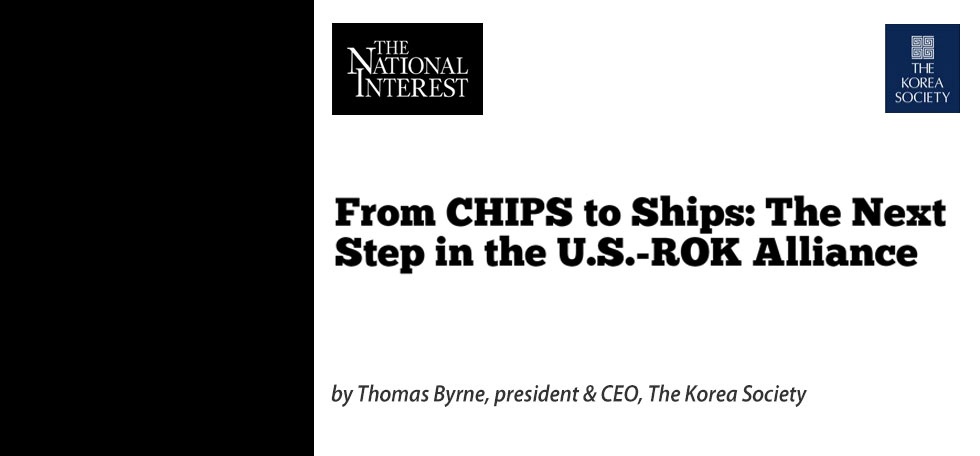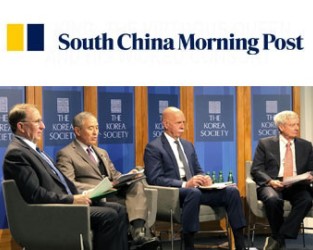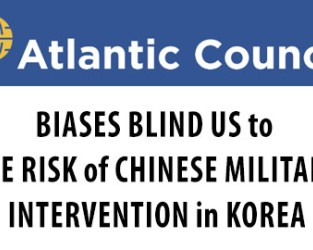![]()
![]()
February 23, 2016
North Korea: The End of “Patience”?
Ambassador Thomas Hubbard
North Korea’s detonation of a nuclear device on January 6 followed by a satellite launch on February 7, while widely predicted, have led to a sharp rise in tensions on the Korean Peninsula and called into question the “strategic patience” that has characterized the US approach to North Korea under the Obama administration. Both steps violate existing UN Security Council resolutions and underscore North Korea’s avowed intention to develop a credible nuclear deterrent. Experts doubt North Korea’s proclamation that it exploded a “hydrogen” device, but this fourth nuclear test nonetheless confirms the fact that the reckless regime in Pyongyang is steadily converting its nuclear capability into a nuclear arsenal. And while the three stage rocket that propelled a second North Korean satellite into orbit may not be immediately convertible into an ICBM, it demonstrates some of the same technologies that will be needed for a weapon. As Secretary of State Kerry pointed out following meetings with Chinese leaders, the situation on the Korean peninsula no longer allows “business as usual.”
A few days I spent in Seoul last week left me convinced that the South Korean Administration of President Park Geun-hye has made a clear break from its efforts to build bridges to the North through a policy of “trustpolitik.” Immediately after the nuclear test, she for the first time announced her government’s willingness to consult with the US on the placement of THAAD anti-ballistic missile batteries in Korea. This step provoked strong protest from China, which has sought to portray a Korea-based THAAD as a US threat to its own security interests.
Following the satellite launch, the ROK went on to impose its strongest unilateral sanctions to date, abruptly announcing the complete shutdown of the Kaesong Industrial Zone in North Korea, where South Korean firms have maintained factories producing goods for export for the past ten years. This will deprive the North Koreans of more than $100 million per year in hard currency earnings. Beyond that, it is a step fraught with symbolic implications. One of the last vestiges of South-North engagement, the ROK had kept Kaesong insulated from the ups and downs of political developments in hopes it would build people-to-people ties and spur economic reform in the North. Not surprisingly, the North responded by freezing South Korean assets at Kaesong, deporting all South Koreans from the Zone, and closing the only highway linking North and South across the demilitarized zone. In a dramatic speech before the National Assembly, the President made clear that she now sees pressure rather than engagement as the only means to deal with the North Korean regime.
Also condemning the North Korean acts in the strongest possible terms, the US, strongly supported by the ROK and Japan, took the lead in pushing for stronger multilateral sanctions in the UN Security Council. China also acknowledged the need for stronger sanctions, but has thus far resisted sanctions that would significantly limit its economic support for the North Korean regime. Following meetings with Secretary Kerry, China agreed that North Korea had violated Security Council resolutions, but argued that the North Korean regime should not be pushed to the point of instability on the Peninsula. Sanctions, in the Chinese view, should be accompanied by renewed negotiations. Chinese Foreign Minister Wang Yi is in Washington this week for further discussion of UN sanctions.
Meanwhile, the US and Japan have moved ahead with enhanced unilateral sanctions. On February 18, President Obama signed into law a set of stringent sanctions intended to limit Pyongyang’s ability to develop and proliferate nuclear weapon and ballistic missiles. The bill imposes restrictions on individuals and entities that engage in “significant activities or transactions” with North Korea that could finance or contribute to the expansion of those programs. This could entail “secondary sanctions” against Chinese or other firms doing business with targeted North Korean entities.
Where will it go from here?
Aside from firmly sealing the Kaesong facility, the North Korean response to international pressure has thus far been primarily rhetorical, though military provocations of the kind we have seen in the past few years can be expected. Shoring up our deterrent posture, the US has reaffirmed our commitments to the ROK and Japan, and underscored our presence through a B-52 overflight of the Peninsula. The US has also taken the unusual step of introducing F-22s to upcoming joint exercises. No one considers the North Korean regime to be suicidal; while an all- out North Korean attack is unlikely, small-scale incidents will occur in the coming months. Restraint will be required by a South Korean Administration that has clearly lost faith in engagement and wants to look tough in the run-up to National Assembly elections in April. The Peninsula will be tense in the next few months.
The medium-term question is how to restrain the inexorable progress in North Korea’s nuclear and missile capability. In the US, everyone agrees that the time for “strategic patience” is over, but strengthened deterrence and stronger sanctions appear to be the only approaches that the American body politic can come up with during this political season. Both the Obama administration and Presidential candidates from both parties insist on squeezing North Korea to the point where it has no choice but to give up its nuclear programs, something which most experts consider unlikely short of regime collapse. Past experience to the contrary, many continue to believe that China, whose principal objective is to avoid collapse in the North, can be persuaded (or forced) to put meaningful pressure on the Pyongyang.
Divisions over how to deal with North Korea are straining regional relationships. In a few short months, North Korea has gone from being a potential source of cooperation between the US and China to becoming a serious bone of contention. South Korea’s budding relationship with China, which it hoped would lead to cooperation on North Korea, has been severely strained. THAAD will be an ongoing source of tension with China, and talk of South Korea going nuclear, though unlikely to become policy, will cause alarm in the US and Japan as well as China. In my view, it is urgent to return to a unified approach to restraining North Korea’s threat to all of us. We do need to apply sanctions, but we should use that pressure to get back to the negotiating table, the only place where we have any hope of solving the various challenges North Korea poses. At this stage, I have come to the view that the best way to engage the Chinese in a constructive effort to constrain the North Korean regime is to return to the long-dormant six-party talks where we can join together in a renewed effort to persuade the North to join the international community. I doubt the North Koreans will be willing to pick up where we left off at the end of the Bush Administration, and we can’t expect an instant commitment to denuclearization. But we may be able to impose a freeze or limits on future development, a key first step toward full denuclearization.
A month and a day after conducting its fourth nuclear test, North Korea launched a multi-stage rocket carrying a 440-pound satellite. The launch of the Taepodong missile from the Tongchang-ri site, near the North’s border with China, on a clear winter Sunday morning on 7 February was another defiant and provocative action, closely following the North’s four nuclear weapons test.
The United Nations Secretary General, Ban Ki-moon[TB1] , decried the launch as "deeply deplorable." President Park Geun-hye castigated the North stating, “North Korea’s launch of a long-range missile not only constitutes an indisputable violation of UN Security Council resolutions, but yet another extreme provocation that ignores the ardent wish of the international community for peace.” China and Russia also formally expressed concerns, especially as China, the North’s main ally, had sent an emissary to dissuade Pyongyang's leadership just days prior to the launch. Japan's Prime Minister Abe called it "absolutely unacceptable.’ The United States Ambassador to the UN Samantha Power called the ballistic missile launch and last month’s nuclear test “hostile and illegal,” and South Korea’s Ambassador to the UN, Oh Joon deemed the launch an "outrage."
The launch was not a surprise, as North Korea had notified three UN agencies earlier that it would occur in the imminent future. The due-south launch trajectory, nonetheless, raised concern among nations in the region as the rocket passed over Okinawa and discarded a stage near the Philippines. Moreover, alarm in the international community was heightened by the evident technological advances so soon after the nuclear test. The rocket’s payload, twice the weight of its 2012 predecessor, was put into orbit with "complete success" according to North Korea. Although the 7 February launch signifies a technological advance, North Korea has not yet demonstrated the capacity to perfect reentry technology, part of what defines a successful intercontinental ballistic missile, guidance systems or warhead miniaturization.
China officially expressed "regret" and "concern," but called for a restrained response and negotiation. In contrast, The New York Times noted that a Weibo social media poll showed that two-thirds of Chinese users were supportive of a US strike on the North's nuclear sites. In the near-term, China will not likely support stricter sanctions called for by others on the UN Security Council and in Washington, Seoul, Tokyo and even Moscow. Chinese President Xi Jinping seems more focused on domestic issues—his sweeping anti-corruption campaign and on the country’s economic and financial challenges. China’s leadership seems to have calculated that accommodating North Korea and seeking to maintain stability on the Peninsula is better than instability; a potential humanitarian crisis on its borders in the event of tumult in North Korea, and the loss of a strategic buffer. China is in no mood to listen further to the United States given the South China Sea discord--a fact made clear in the Sino-US diplomatic posturing that followed the January 6 missile test.
The 7 February launch could have longer term strategic consequences for the peninsula and East Asia region. South Korea might have greater willingness to adopt the US Terminal High Altitude Area Defense system. If THAAD gains popularity with South Korea (and other Asian allies), China-US relations will be sorely tested, as China fears the system's check against its own capabilities. Tensions are already high given Beijing’s territorial claims in the South China Sea. North Korea's launch raises those tensions only higher.
All this leaves the international community decrying the test and February 7 launch, yet constrained in its ability to reign in a Pyongyang. Upcoming US-South Korea Key Resolve military maneuvers will see a spike in rhetoric that may rival or surpass that between North Korea and the US and its allies in the spring of 2013. And North Korean leader Kim Jong Un will continue to display toughness in advance of his May party congress, the first since 1980.
One might hope that later this year North Korea will initiate another diplomatic charm offensive, as it has regularly done so after spiking tensions over the years. What the young leader may have failed to calculate, however, is the deepening doubt in Beijing of his capabilities relative to his disruptions, his diplomatic insults to China's leadership, and his driving of Seoul to upgrade its military capabilities. Meanwhile the global non-proliferation regime stands tattered and in need of reinforcement.
[TB1]Pls cite the who in the UN, the GS’s office?










